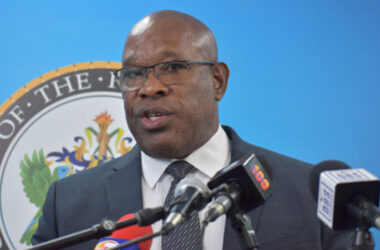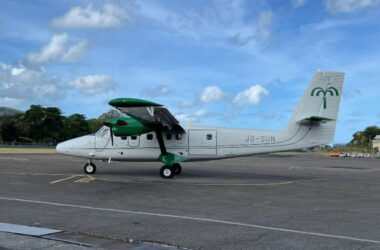THE official findings of an archaeological survey, conducted on the northern end of the Cas-en-Bas beach, that seems to have cleared the way for Cabot Saint Lucia to continue works in that area have been rejected by both the Saint Lucia National Trust and the Saint Lucia Archeological and Historical Society.
The Trust and the Society, which both gave their blessings for the survey to be done, in a joint statement, noted that due process was compromised when the developer released certain aspects of the report’s findings in advance of its consideration by the DCA and its referral agencies, in accordance with normal development control procedures.

The Trust and the Society, which also approved of the archeological assessment by Archaeologist Dr. Reginald Murphy, stated that the commitments given by Cabot that no work will be conducted in the Archaeological Priority Area until an archaeological assessment is conducted were not given in good faith as Cabot started and continues to undertake earth movement works in the area, contrary to its commitments and in contravention of the approvals granted by the DCA.
The Trust and the Society highlighted several areas in the survey’s findings that they have problem with, including areas of inconsistencies that left them with no choice but to reject the survey in its totality.
Review of the Archaeological Investigation of the Cabot Development
The Saint Lucia National Trust (the Trust) and the Saint Lucia Archaeological and Historical Society (AHS) have been advocating for the conduct of an Archaeological investigation of the area of land on the south east corner of the Cabot (Saint Lucia) development since 2019 and been advising on what should be included in the Terms of Reference with both the developer and the Development Control Authority during conversations and in writing.
In addition, Section 7.3.4 of the updated Environmental and Social Impact Assessment conducted by the specialists contracted to do the study in 2020 contains specific undertakings to be followed in relation to the Archaeological Priority Area identified in the development plans.
Our review of the Archaeological assessment of the area in question, reported to have been conducted by Archaeologist Dr. Reginald Murphy, is done in the context of these recommendations and commitments. It is unfortunate that the National Trust was not engaged at any point in this assignment, from field work through to presentation of findings as the organization has a legal mandate to promote the preservation of objects of archaeological, historic or traditional interest.
We also believe that due process was compromised when the developer released certain aspects of the report’s findings in advance of its consideration by the DCA and its referral agencies, in accordance with normal development control procedures.
The developer gave commitments to both the Trust and the AHS that no work will be conducted in the Archaeological Priority Area until an Archaeological assessment is conducted and, in any case, that this site will not be developed until phase 3 of the project. These commitments were not given in good faith as the developer started and continues to undertake earth movement works in the area, contrary to his commitments and in contravention of the approvals granted by the DCA.
These works would have further compromised the Archaeological value of the site and we are at a loss to understand why the DCA decided not to heed our call for action to prevent the contravention of the terms of its approval when this matter was brought to its attention by the Trust in January of this year.
Furthermore, the role of the DCA’s Check Consultant is to monitor the developer’s activities and report on its compliance with the ESIA requirements. Unfortunately, referral agencies are not privy to his reports, but we would expect this encroachment to have been identified in his reporting as a non-compliance issue, and would expect the DCA to take the appropriate action to ensure compliance with the conditions of its approval.
The DCA provided the following as the Terms of Reference (TORs) for the Investigation:
Terms of Reference: Archaeological and Historical Impact Assessment:
1. An Archaeological Impact Assessment (AIA) should be conducted at the site under the guidance of the Saint Lucia Archaeological and Historical Society. This assessment to provide an inventory of all historic and archaeological assets, and the proposed mitigative actions to protect any components and artefacts discovered at the site. Consideration should be given to identifying and establishing boundaries and addressing access to the archaeological site.
2. Provide a clearer indication of a timeline for the activities recommended in 7.3.4 – Preservation of Archaeological Sites (of the 2020 Environmental and Social Impact Assessment conducted by the Developer which lays out how the Archaeological Priority Area should be treated, including the prohibition of any work until the AIA is completed, procedures to be followed if artefacts are found and procedures for the retrieval and preservation)
3. Indicate measures and mechanisms for the proposed archaeological oversight as it pertains to responsibilities, relationships, information management, etc. which clarify system of monitoring works and means of liaising with the relevant government agencies.
4. Outline measures to ensure that, as large earth moving equipment operations are ongoing, personnel onsite can alert the operator to the unearthing of artefacts.
5. Articulate unambiguous guidelines to identify, retrieve, record and protect artefacts that may be uncovered during the construction phase.
Analysis of the AIA: In general, we submit that the AIA is not sufficiently responsive to these TORs and the report should be rejected on these grounds. Notwithstanding, we reviewed the Report and provide the following for consideration:
a) In the 2020 ESIA the developer submitted that test pits in the focus area should take two (2) to three (3) weeks and that the developer shall not commence any work in the area of interest until such detailed investigation is performed. While in our view this is not sufficient time to conduct a thorough investigation of the several acres of the area of focus, the assessment conducted lasted one week, which would explain the limitations and inconsistencies in its findings and conclusions.
b) According to the report a walk over did not identify cultural material. Ten (10) test pits were dug in the beach area and sifted through the extracted material to see if any existed. The conclusion was that “This area of the beach is sterile of archaeological/cultural materials and as such, there are no issues to prevent development from an archaeological perspective”. We have difficulty with the generalization of this conclusion because these test pits are at the bottom of a slope which is heavily forested. A sterile beach does not indicate a sterile site.
c) Later in the report reference is made to an additional sixteen (16) test pits dug in an area already investigated by other researchers and listed six hundred and thirteen (613) items were found. It goes on to state that “diagnostically they represent Late Ceramic Age Arawakan cultures and people who were living in the Lesser Antilles between AD 1,200 and AD 1,400”. This assessment confirms that the site still holds a considerable amount of cultural material worthy of more detailed research and this should inform the way forward as it is in line with much of the research which has been conducted on the site. The use of heavy construction equipment on the site may endanger material culture which may be buried on that site.
d) Another part of the report states that “as the survey was limited to one-week field time, no intensive analysis of the recovered materials, other than to identify cultural affiliations and type of material culture, could be done.” This statement is a clear red flag for cultural heritage managers since it is an admission that the period of investigation was not sufficient to allow for many of the definitive conclusions contained in the report. The ESIA indicated that, a two to three-week investigation was needed for a proper evaluation of the site. A one-week investigation cannot be construed as having met those terms or having produced results which can be used to inform decisions on this massive site.
e) The Report states that a walk over survey was carried out in the extended area most favorable to pre-Colombian settlement and goes on to state that “no archaeological sites, or cultural deposits, or features were found”. We find this conclusion puzzling because a walk over while diagnostic cannot uncover archaeological sites or cultural deposits. The urgency of this investigation and the demonstrated significance of the site by previous investigations demands a more engaged approach. Test pits are necessary for any informed conclusions on the site. The lack of test pits and an engaged investigation are clear evidence of the impact of the limited time within which the archaeologist was allowed to investigate the site. The fact that the general area has produced massive amounts of Pre-Columbian cultural material necessitated more intense investigation. As a result, we see this conclusion as a flawed one.
f) We have difficulty with the conclusion in the report that “From an archaeological perspective, there is not sufficient cultural deposition left to justify blocking development on this point of land” because of the limited area and focus of this survey. Based on the map showing the location of test pits it is clear that those pits were dug in areas which are easily accessible. These areas border sites of previous archaeological investigations and did not enter the heavily forested area which has never been tested and is in close proximity to those sites. The results from these areas are therefore not sufficient to inform a conclusion about the entire Archaeological Priority Area.
g) The Report goes on to state that” However, should the development extend uphill onto the forested area above the beach, it is advisable to have an Archaeologist be present for rapid recovery should any important features be found”. This statement is an admission of the limited scope of the investigation because:
• The Report includes a plan for the development which clearly shows that it does; and
• This recommendation is clear indication that the area SHOULD have been investigated in the first place. The only reason for the suggestion is that the area is likely to produce Pre-Columbian material culture. It was not investigated so the suggestion is a catch all for what might have been missed.
While we stated earlier in this analysis that the Report should be rejected because it was not sufficiently responsive to the Terms of Reference, we now reaffirm this recommendation on the basis of the inconsistencies mentioned above.
International Obligations: With regards to International Law, Saint Lucia is a Party to:
a) The United Nations Declaration of the Rights of Indigenous People (UNDRIP) under which Parties have an obligation to protect the rights of indigenous peoples, including the protection of historic sites and cultural artefacts;
b) The International Convention on the Elimination of all forms of Racial Discrimination (the CERD) which, in 2004, communicated to the Government of Saint Lucia its concern over Saint Lucia’s disregard for the rights of indigenous peoples; and
c) The World Heritage Convention which calls on Parties to protect the works of man or the combined works of nature and man, and areas including archaeological sites which are of outstanding universal value for their historical, aesthetic, ethnological of anthropological point of view.
We submit that the Cabot development will place Saint Lucia in conflict with its obligations under these Treaties and on the basis of the analysis above, call on the responsible national authorities to take the necessary steps to prevent the further degradation of the Archaeological Priority Area.
A Place of Memory: In addition to the specific issues we have with the Report and the conflicts with international treaties, these are other concerns with the development.
a) Places of Memory are important components of the culture and patrimony of any group, culture or country. The Archaeological Priority Area is one such place and the government has the responsibility to the nation as well as under The United Nations Declaration of the Rights of Indigenous People, to protect this area. This is clearly acknowledged in the report when it states that “the proposed development of the site should somehow reflect its great importance as a former pre-Columbian cultural landscape. Perhaps some form of recognition could be incorporated into the site reflecting elements of the pre-Columbian history and culture.” The preservation of this area as a Place of Memory is the responsibility of the Government of Saint Lucia who should ensure that its importance is reflected in any development approvals to be granted to the developer.
b) Retaining this site as a Place of Memory will enhance the tourism value of the development and create a unique place for reflection, education and heritage tourism. Its uniqueness would generate much interest and curiosity, thereby creating new and diverse opportunities for employment, entrepreneurship and interpretation and will be a demonstration of responsible development. Neither the developer nor the Government should allow this opportunity to be missed.
Balancing Development and Conservation: We have taken note of the usual justification by public authorities that the jobs to be created justify the destruction of this important pace of memory. This idea also appeared in the archaeological report. While we reject this argument on legal and moral grounds, we also point out that this area is small compared to the scale of the development and will not jeopardize the jobs that will be created if the Archaeological Priority Area is removed from the footprint of the development and converted into a Place of Memory. This approach will begin to find the balance between development and conservation and serve as an approach to be replicated for the benefit of developers and the country as a whole.
Development of the Queen’s Chain: The map shows the Archaeological Priority Area in which there are plots of land demarcated by the developer. This signals the intention of the developer to sell parts of the Archaeological Priority Area for development. Of greater concern, these plots of land extend into the Queen’s Chain, signaling the developer’s intention to transfer ownership and control of parts of the Queen’s Chain to private persons. Should this be the case, we expect the Authorities to prevent it from happening as it is inconsistent with national policies and law.
We are increasingly concerned by the growing tendency for developments to be allowed in areas that are known to be of historic, cultural, anthropological or natural value not yet sufficiently examined. development on this point of land” because of the limited area and focus of this survey. Based on the map showing the location of test pits it is clear that those pits were dug in areas which are easily accessible. These areas border sites of previous archaeological investigations and did not enter the heavily forested area which has never been tested and is in close proximity to those sites. The results from these areas are therefore not sufficient to inform a conclusion about the entire Archaeological Priority Area.
g) The Report goes on to state that” However, should the development extend uphill onto the forested area above the beach, it is advisable to have an Archaeologist be present for rapid recovery should any important features be found”. This statement is an admission of the limited scope of the investigation because:
• The Report includes a plan for the development which clearly shows that it does; and
• This recommendation is clear indication that the area SHOULD have been investigated in the first place. The only reason for the suggestion is that the area is likely to produce Pre-Columbian material culture. It was not investigated so the suggestion is a catch all for what might have been missed.
While we stated earlier in this analysis that the Report should be rejected because it was not sufficiently responsive to the Terms of Reference, we now reaffirm this recommendation on the basis of the inconsistencies mentioned above.
International Obligations: With regards to International Law, Saint Lucia is a Party to:
a) The United Nations Declaration of the Rights of Indigenous People (UNDRIP) under which Parties have an obligation to protect the rights of indigenous peoples, including the protection of historic sites and cultural artefacts;
b) The International Convention on the Elimination of all forms of Racial Discrimination (the CERD) which, in 2004, communicated to the Government of Saint Lucia its concern over Saint Lucia’s disregard for the rights of indigenous peoples; and
c) The World Heritage Convention which calls on Parties to protect the works of man or the combined works of nature and man, and areas including archaeological sites which are of outstanding universal value for their historical, aesthetic, ethnological of anthropological point of view.
We submit that the Cabot development will place Saint Lucia in conflict with its obligations under these Treaties and on the basis of the analysis above, call on the responsible national authorities to take the necessary steps to prevent the further degradation of the Archaeological Priority Area.
A Place of Memory: In addition to the specific issues we have with the Report and the conflicts with international treaties, these are other concerns with the development.
a) Places of Memory are important components of the culture and patrimony of any group, culture or country. The Archaeological Priority Area is one such place and the government has the responsibility to the nation as well as under The United Nations Declaration of the Rights of Indigenous People, to protect this area. This is clearly acknowledged in the report when it states that “the proposed development of the site
should somehow reflect its great importance as a former pre-Columbian cultural landscape. Perhaps some form of recognition could be incorporated into the site reflecting elements of the pre-Columbian history and culture.” The preservation of this area as a Place of Memory is the responsibility of the Government of Saint Lucia who should ensure that its importance is reflected in any development approvals to be granted to the developer.
b) Retaining this site as a Place of Memory will enhance the tourism value of the development and create a unique place for reflection, education and heritage tourism. Its uniqueness would generate much interest and curiosity, thereby creating new and diverse opportunities for employment, entrepreneurship and interpretation and will be a demonstration of responsible development. Neither the developer nor the Government should allow this opportunity to be missed.
Balancing Development and Conservation: We have taken note of the usual justification by public authorities that the jobs to be created justify the destruction of this important pace of memory. This idea also appeared in the archaeological report. While we reject this argument on legal and moral grounds, we also point out that this area is small compared to the scale of the development and will not jeopardize the jobs that will be created if the Archaeological Priority Area is removed from the footprint of the development and converted into a Place of Memory. This approach will begin to find the balance between development and conservation and serve as an approach to be replicated for the benefit of developers and the country as a whole.
Development of the Queen’s Chain: The map shows the Archaeological Priority Area in which there are plots of land demarcated by the developer. This signals the intention of the developer to sell parts of the Archaeological Priority Area for development. Of greater concern, these plots of land extend into the Queen’s Chain, signaling the developer’s intention to transfer ownership and control of parts of the Queen’s Chain to private persons. Should this be the case, we expect the Authorities to prevent it from happening as it is inconsistent with national policies and law.
We are increasingly concerned by the growing tendency for developments to be allowed in areas that are known to be of historic, cultural, anthropological or natural value not yet sufficiently examined.
Further, we are compelled to act in consideration of imminent challenges posed by climate change and of our commitments under various international laws and conventions. We welcome the renewed commitment by partner agencies to work together to maximise opportunities for diverse and inclusive livelihoods through effective custodianship and celebration of our heritage assets to meet the needs of the current generation without compromising the ability of future generations to meet their own needs.
Saint Lucia National Trust Saint Lucia Archaeological & Historical Society May 10, 2021














